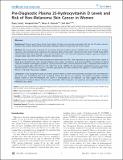| dc.contributor.author | Liang, Geyu | |
| dc.contributor.author | Nan, Hongmei | |
| dc.contributor.author | Qureshi, Abrar A. | |
| dc.contributor.author | Han, Jiali | |
| dc.date.accessioned | 2012-12-21T18:30:57Z | |
| dc.date.issued | 2012 | |
| dc.identifier.citation | Liang, Geyu, Hongmei Nan, Abrar A. Qureshi, and Jiali Han. 2012. Pre-diagnostic plasma 25-hydroxyvitamin D levels and risk of non-melanoma skin cancer in women. PLoS ONE 7(4): e35211. | en_US |
| dc.identifier.issn | 1932-6203 | en_US |
| dc.identifier.uri | http://nrs.harvard.edu/urn-3:HUL.InstRepos:10121032 | |
| dc.description.abstract | Background: Recent reports have shown that vitamin D status was inversely associated with the risk of various cancers. However, few studies examined the association between vitamin D levels and risk of skin cancer. Methods: We prospectively evaluated the association between baseline plasma 25(OH)D levels and the risk of incident squamous cell carcinoma (SCC) and basal cell carcinoma (BCC) among 4,641 women from the Nurses’ Health Study (NHS) and the NHS II with 510 incident BCC cases and 75 incident SCC cases. We used multivariate logistic regression models to calculate odds ratios (ORs) and 95% confidence intervals (CIs). Results: Plasma 25(OH)D levels were positively associated with risk of BCC after adjusting for age at blood draw, season of blood draw, lab batch, hair color, burning tendency, the number of sunburns, and ultra-violet B flux of residence at blood collection. Women in the highest quartile of 25(OH)D had more than 2-fold increased risk of BCC compared with women in the lowest quartile (OR = 2.07, 95% CI = 1.52–2.80, P for trend <0.0001). We also found a significantly positive association between plasma 25(OH)D levels and SCC risk after adjusting for the same covariates (OR, highest vs. lowest quartile = 3.77, 95% CI = 1.70–8.36, P for trend = 0.0002). Conclusion: In this prospective study of women, plasma vitamin D levels were positively associated with non-melanoma skin cancer risk. Considering that most circulating vitamin D is due to sun exposure, the positive association between plasma vitamin D and non-melanoma skin cancer is confounded by sun exposure. Our data suggest that one-time measurement of plasma vitamin D levels may reasonably reflect long-term sun exposure and predict the risk of non-melanoma skin cancer. | en_US |
| dc.language.iso | en_US | en_US |
| dc.publisher | Public Library of Science | en_US |
| dc.relation.isversionof | doi:10.1371/journal.pone.0035211 | en_US |
| dc.relation.hasversion | http://www.ncbi.nlm.nih.gov/pmc/articles/PMC3320875/pdf/ | en_US |
| dash.license | LAA | |
| dc.subject | medicine | en_US |
| dc.subject | clinical research design | en_US |
| dc.subject | cohort studies | en_US |
| dc.subject | epidemiology | en_US |
| dc.subject | dermatology | en_US |
| dc.subject | skin neoplasms | en_US |
| dc.subject | malignant skin neoplasms | en_US |
| dc.subject | basal cell carcinomas | en_US |
| dc.subject | squamous cell carcinomas | en_US |
| dc.subject | diagnostic medicine | en_US |
| dc.subject | pathology | en_US |
| dc.subject | general pathology | en_US |
| dc.subject | biomarkers | en_US |
| dc.subject | cancer epidemiology | en_US |
| dc.subject | nutrition | en_US |
| dc.subject | vitamins | en_US |
| dc.subject | public health | en_US |
| dc.subject | preventive medicine | en_US |
| dc.subject | women's health | en_US |
| dc.title | Pre-Diagnostic Plasma 25-Hydroxyvitamin D Levels and Risk of Non-Melanoma Skin Cancer in Women | en_US |
| dc.type | Journal Article | en_US |
| dc.description.version | Version of Record | en_US |
| dc.relation.journal | PLoS ONE | en_US |
| dash.depositing.author | Han, Jiali | |
| dc.date.available | 2012-12-21T18:30:57Z | |
| dc.identifier.doi | 10.1371/journal.pone.0035211 | * |
| dash.contributor.affiliated | Han, Jiali | |


